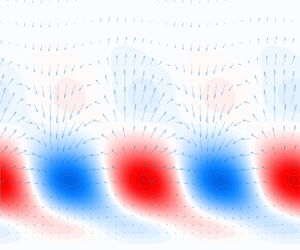Article contents
Linear and nonlinear receptivity mechanisms in boundary layers subject to free-stream turbulence
Published online by Cambridge University Press: 16 January 2024
Abstract

Large-eddy simulations of a flat-plate boundary layer, without a leading edge, subject to multiple levels of incoming free-stream turbulence are considered in the present work. Within an input–output model, where nonlinear terms of the incompressible Navier–Stokes equations are treated as an external forcing, we manage to separate inputs related to perturbations coming through the intake of the numerical domain, whose evolution represents a linear mechanism, and the volumetric nonlinear forcing due to triadic interactions. With these, we perform the full reconstruction of the statistics of the flow, as measured in the simulations, to quantify pairs of wavenumbers and frequencies more affected by either linear or nonlinear receptivity mechanisms. Inside the boundary layer, different wavenumbers at near-zero frequency reveal streaky structures. Those that are amplified predominantly via linear interactions with the incoming vorticity occur upstream and display transient growth, while those generated by the nonlinear forcing are the most energetic and appear in more downstream positions. The latter feature vortices growing proportionally to the laminar boundary layer thickness, along with a velocity profile that agrees with the optimal amplification obtained by linear transient growth theory. The numerical approach presented is general and could potentially be extended to any simulation for which receptivity to incoming perturbations needs to be assessed.
Information
- Type
- JFM Papers
- Information
- Copyright
- © The Author(s), 2024. Published by Cambridge University Press
References
- 4
- Cited by


